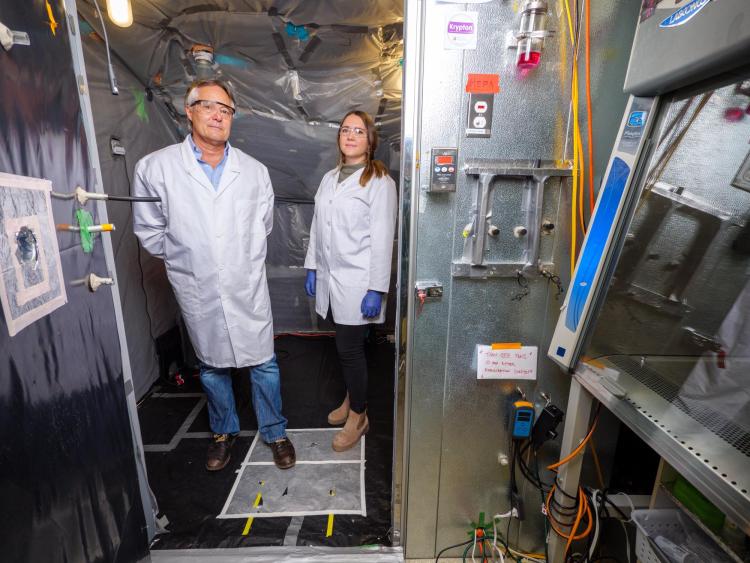Unique bioaerosol lab, dedicated students made COVID research possible
As one of the first interdisciplinary bioaerosol labs established in the U.S., the Environmental Engineering Microbiology and Disinfection Lab at CU Boulder is home to one of the biggest bioaerosol chambers in the country at an academic institution. At about 350 cubic feet (10 cubic meters), it provides a large experimental space that realistically mimics the indoor environments people live, work and play in every day.
While set up to study infectious airborne particles, this state-of-the-art facility is one of the safest places on campus, said Mark Hernandez, S. J. Archuleta Professor of Civil and Environmental Engineering and director of the lab. Equipped with top-tier indoor air ventilation and filtration, it receives 100% fresh air from outside the lab and undergoes 12 air changes per hour (ACH)—an industry gold standard.

Professor Mark Hernandez and doctoral graduate Marina Nieto-Caballero stand inside the 10-cubic-meters bioaerosol chamber used to study live airborne coronavirus persistence in the Environmental Engineering disinfection laboratory at the Sustainability, Energy and Environment Complex (SEEC). Photo by Patrick Campbell/University of Colorado.
But the most important part of the lab’s recent COVID-19 research was having the right people in the right place at the right time, said Hernandez.
Marina Nieto-Caballero had one year left in her doctoral program, one last chapter of her thesis yet to write, and a career-changing decision to make in 2020: Should she switch from studying bacteria and microbes to focusing on the virus that had come to dominate the world’s attention?
“It was very important to me to be able to have an impact during this pandemic,” said Nieto-Caballero.
Her gut decision to take this “hard left turn” was influenced by the timely presence of virologist and study co-author Eddie Fuques, who had come to the lab as a visiting researcher but could not return to his home country of Uruguay due to sudden travel restrictions. He stayed several extra months with the team and helped Nieto-Caballero pivot her research focus.
Odessa Gomez, one of Hernandez’s previous students who now works at the Colorado Department of Public Health and Environment as an Indoor Air Quality Assessment Program supervisor, also came back to assist with this project and other COVID-related research.
This team of CU Boulder researchers, alumni and visiting collaborators worked for 18 straight weeks, on weekdays and weekends, day and night, to complete this work in 2020.
For their recent study published in PNAS-Nexus, the team used murine hepatitis virus (MHV), a coronavirus that is very closely related to its pathogenic human counterpart SARS-CoV-2—however, it cannot infect humans. MHV is now a widely accepted model for pathogenic human viruses in scientific settings. At this CU Boulder engineering-based disinfection lab, MHV is grown on mouse brain tumor cells in a secure and safe laboratory space.
While maintaining a cozy room temperature of 71.6 degrees F (22 C), the researchers sprayed droplets of the virus mixed with artificial saliva into the large, sealed chamber, closely mimicking what humans release when we breathe and speak. Fans were used to mix the particles within the chamber, as the researchers took measurements of the particles while they floated around for two hours. In their data, they also accounted for the particles that had landed on the wall, floor and ceiling of the chamber. After each testing session, the sealed chambers were also zapped with ultraviolet light (UV) so that no infectious particles remained.
Specialized equipment placed inside the sealed chambers collected samples, which were then tested for infectious virus, and finally, visually interpreted by researchers with a computer aided high-resolution microscope. While healthy cells created a consistent pattern of small dots across the screen, infected cells looked pulled apart, ravaged.
“That's what it does when it gets in your brain or your lungs,” said Hernandez. “When you see that, it is remarkable—the damage that the virus can do.”


